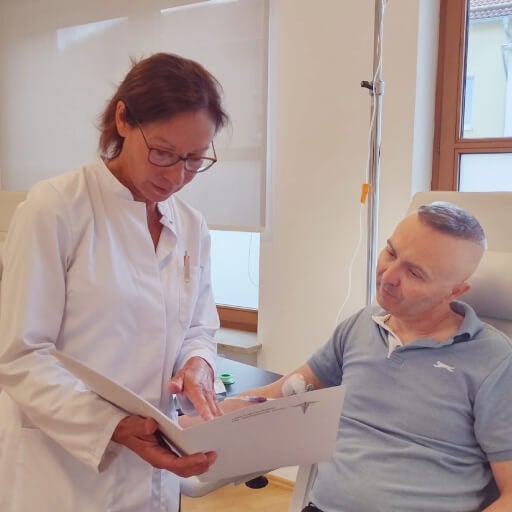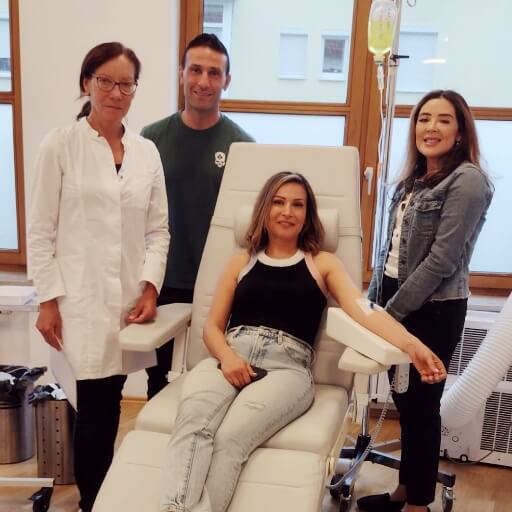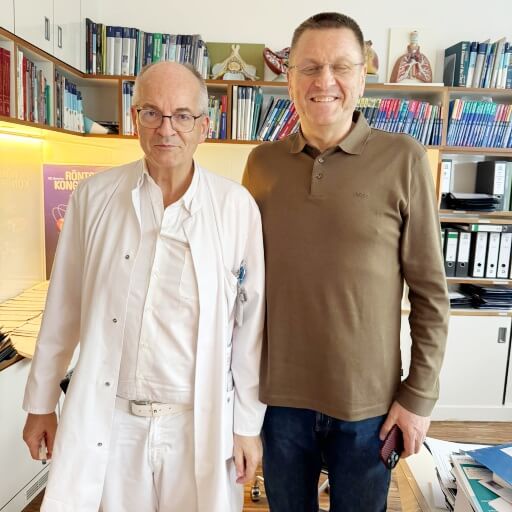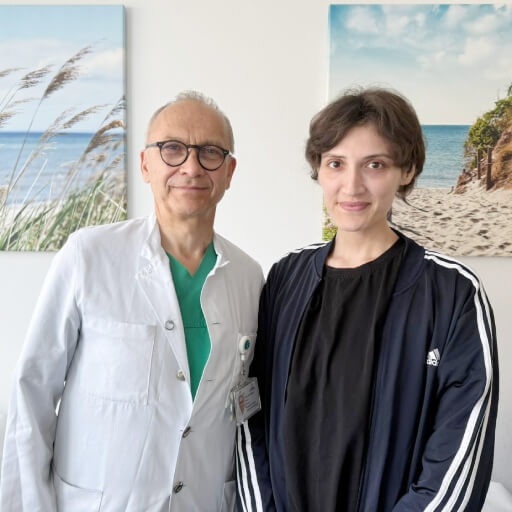With 2.5 million new cases in 2022 and 1.8 million deaths [1], lung cancer remains the most common cancer diagnosed worldwide. The challenge is early detection: only 17% and 15% of lung cancers in women and men, respectively, are diagnosed at stage 1, when survival is 80-93%. Those with advanced lung cancer have survival rates of less than 20% [2]. German healthcare systems demonstrate superior outcomes, with survival rates for both non-small cell lung cancer and small cell lung cancer relatively high compared to other European countries [3]. Early detection through advanced diagnostics for lung cancer offers the best hope for successful treatment outcomes.
Why Lung Cancer is Hard to Detect Early
Unfortunately, even in the presence of healthcare facilities and diagnostic equipment, successful screening for lung cancer and timely detection of lung tumors are not always possible. This is because lung cancer can be asymptomatic until it becomes more advanced – the typical feature of many malignant tumors. Even more, lung cancer symptoms are non-specific: they resemble common respiratory problems – another contribution to delayed diagnosis making.
Lung tumors often grow large before they cause pain, as the lung tissue consists of alveoli and lacks nerve endings. Respiration is adaptive and patients unconsciously alter breathing patterns and activity levels to compensate for declining lung function. For months or years, this adaptation may hide developing lung cancer cells.
Most lung tumors begin in peripheral regions of the lungs away from the main airways, where they may cause significant symptoms. They may become quite large before impairing normal lung function or becoming detectable on screening imaging studies.
Subjective lung cancer symptom recognition also contributes to delayed diagnosis. Some patients – especially smokers – are guilted or deluded into not seeking immediate medical attention. They may fear confirmation of their worst lung cancer suspicions or be judged on lifestyle choices that led to their present condition.
The common early lung cancer symptoms and their wrong explanations are as follows:
- A cough that persists which is mistaken for a "smoker's cough" or seasonal allergies
- Shortness of breath contributed to older age or inactivity
- Aches and pains in the chest that are mistaken for muscle strain
- Fatigue that patients attribute to stress or a busy lifestyle
The peculiarity of lung cancer cough is that patients often feel as if there's something inside the bronchus they're trying unsuccessfully to clear. This becomes chronic, yet many dismiss it as normal. Lung cancer patients frequently describe it as a tickling or scratching sensation deep in their chest that they cannot satisfy, no matter how much they cough.
Many lung cancer patients also experience subtle changes that they don't immediately connect to lung health. Weight loss, when it occurs in early stages, is often gradual and attributed to stress or lifestyle changes. Night sweats may be dismissed as hormonal changes. Some lung cancer patients notice they tire more easily during activities they previously handled with ease, but attribute this to natural aging.
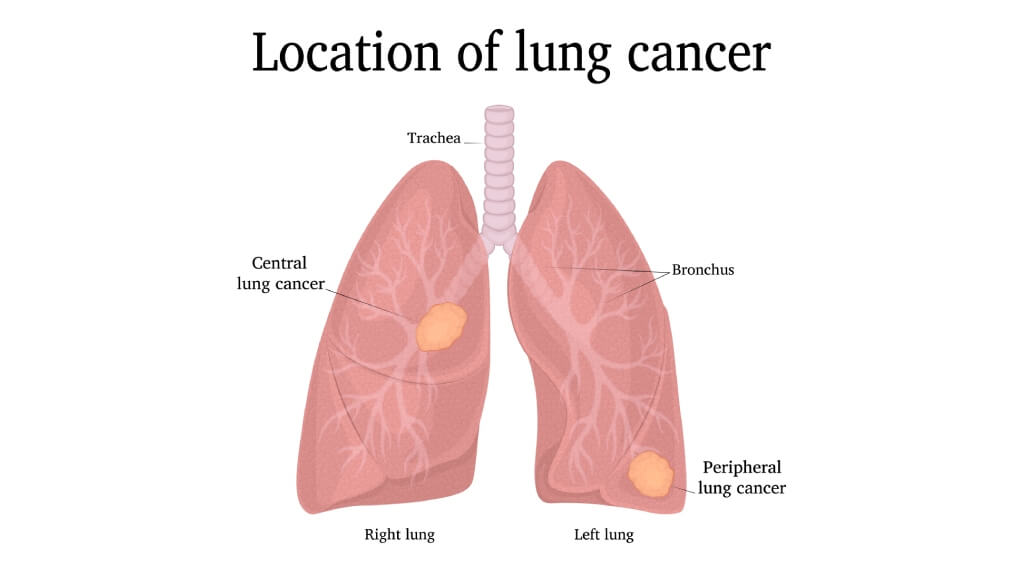
Why Traditional Approaches to Lung Cancer Detection Fall Short
Standard chest X-rays can only see small tumors, including those hidden behind the heart or ribs. Lung cancer often develops far beyond the very earliest, most treatable stages when it first appears on routine X-rays. This diagnostic gap explains why many patients have lung cancer diagnosed only at stage 3 or 4, when radical lung cancer treatment is much more challenging.
The limitations of chest X-rays become apparent when going deeper into the lung anatomy. A standard chest X-ray is only two-dimensional, and small tumors may be completely obscured by overlapping structures like the heart, major blood vessels or ribs. Also, tumors must be at least a centimeter in diameter before lung cancer shows up on conventional X-rays – by then, lung cancer may already be metastatic.
Timing issues are another disadvantage of traditional diagnostic approaches. Most healthcare systems perform annual chest X-rays for high-risk patients but tumors grow quickly between lung cancer screening intervals. A small, possibly curable tumor may progress to an advanced stage with limited lung cancer treatment options.
Chest X-ray interpretation is a second challenge. Even experienced radiologists sometimes miss small nodules or describe lung cancer as benign findings like scar tissue or infection-related changes.
Advanced Lung Cancer Diagnostic Methods Available in Germany
German medical centers have invested in advanced diagnostic technology and specialized expertise for better early lung cancer detection rates. Advanced equipment, strict quality standards and experienced medical teams combine to identify small tumors before cancer spreads.
The German approach is a step away from reactive medicine towards proactive, precision lung cancer detection. Such a broad strategy requires state of the art technology and systematic protocols to ensure uniform, high-quality diagnostic procedures in all medical facilities. Quality assurance standards and continuous improvement programs keep German hospitals at the forefront of medical science for their diagnostic capabilities.
Germany's medical centers offer multidisciplinary cooperation during diagnosis making. Pulmonologists, radiologists, and oncologists perform joint examinations for suspected lung cancer to provide each patient with the expertise and the most accurate diagnosis.
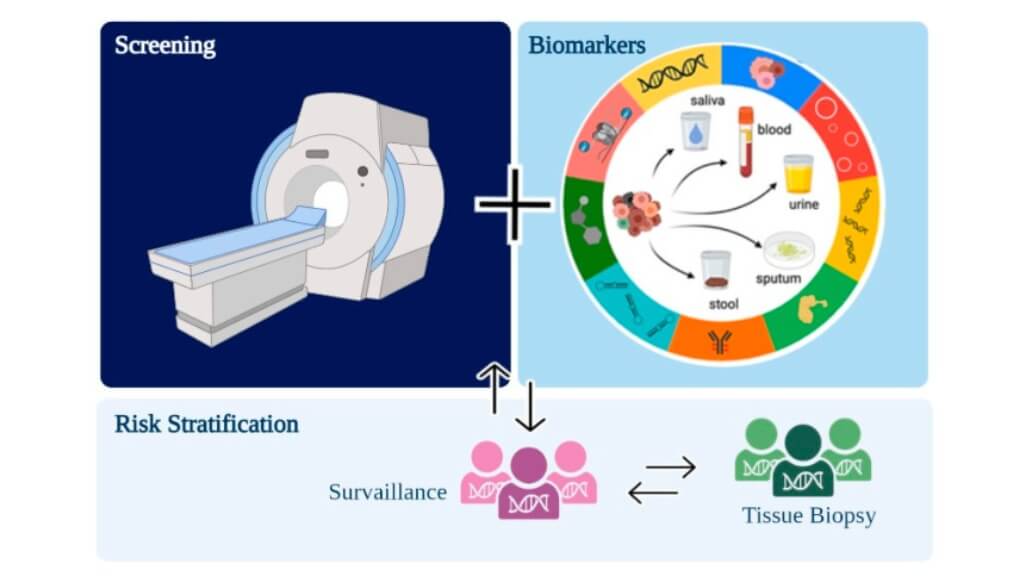
High-Resolution Imaging Tests for Lung Cancer Detection
The latest generation CT scan devices in modern German hospitals detect lung cancer nodules as small as 2-3 millimeters. These advanced systems offer:
- Low-dose protocols that minimize radiation and preserve diagnostic accuracy
- AI-assisted detection software that flags suspicious areas for radiologist review
- Dual-energy technology that distinguishes between different tissue types
Artificial intelligence has entered into German diagnostic imaging. AI systems trained on thousands of non-small cell lung cancer and small cell lung cancer cases can spot subtle patterns that human eyes cannot detect and serve as a support to expert radiologist interpretation.
German radiologists receive special training to maximize the diagnostic potential of each scan. They use special viewing software that allows them to examine images in several planes and with different enhancement techniques, as cancer cells may be missed by less sophisticated technology.
PET-CT Fusion Imaging Tests for Lung Cancer Detection
This sophisticated technique combines metabolic and anatomical information in a single examination. This test identifies regions where cancer cells are more active but structural changes are not yet detectable on standard imaging tests.
PET-CT fusion imaging tests combine functional information derived from PET with anatomical images acquired by computed tomography. Cancer cells usually have a greater metabolic activity than normal cells and so take in more of radioactive glucose in PET scans. German medical centers refined this technology for better diagnostic accuracy and patient comfort.
Dietary instructions and timing requirements used at German facilities ensure ideal conditions for scanning, including maximum contrast between cancer cells and normal tissue. Imaging test protocols have been optimized to obtain the best quality images with minimum scan time and radiation exposure.
Specialized Bronchoscopy Procedures for Lung Cancer Detection
German pulmonologists employ various advanced bronchoscopic techniques:
- Regional lymph node assessment with endobronchial ultrasound (EBUS)
- Reaching peripheral nodules with electromagnetic navigation bronchoscopy
- Advanced tissue biopsy techniques that allow for receiving more representative tissue samples
As with GPS navigation, electromagnetic fields direct the bronchoscope to small nodules in peripheral lung areas that were previously not accessible. German medical centers have modern bronchoscopy rooms with real-time imaging tests.
Endobronchial ultrasound in German hospitals permits ultra-detailed evaluation of lymph nodes and other structures bordering the airways. It enables physicians to determine cancer spread to nearby lymph nodes without surgical biopsy or other more invasive procedures and to increase tissue sampling accuracy.
Laboratory Diagnostics and Biomarkers for Lung Cancer Detection
German laboratories perform full testing for small cell lung cancer and non-small cell lung cancer, for example:
- Tumor marker NSSE, CEA, CYFRA 21-1
- Genetic mutation analysis for personalized lung cancer treatment plans
- Inflammatory markers that distinguish lung cancer from other conditions
Measuring these tumor markers requires advanced laboratory techniques and quality control, which German medical centers keep at very high standards. NSE is highest for small cell lung cancers, whereas CEA and CYFRA 21-1 are associated with non-small cell lung cancers.
German laboratories define precise reference ranges and interpretation guidelines for physicians to understand the significance of these results in the context of each patient's clinical situation and medical history.
Liquid Biopsy Technology for Lung Cancer Detection
A very exciting development in lung cancer diagnostics is liquid biopsy. This revolutionary method analyzes circulating tumor DNA in blood – potentially detecting cancer cells before they appear on imaging tests. With this technology, German laboratories have achieved high accuracy rates and are improving the techniques for early detection.
The liquid biopsy process is simple for a patient but advanced technically. It involves molecular analysis (more often, of blood) for finding genetic mutations and other molecular markers of non-small cell lung cancer and small cell lung cancer. Modern sequencing technology and protocols developed in German laboratories ensure consistent, reliable results.
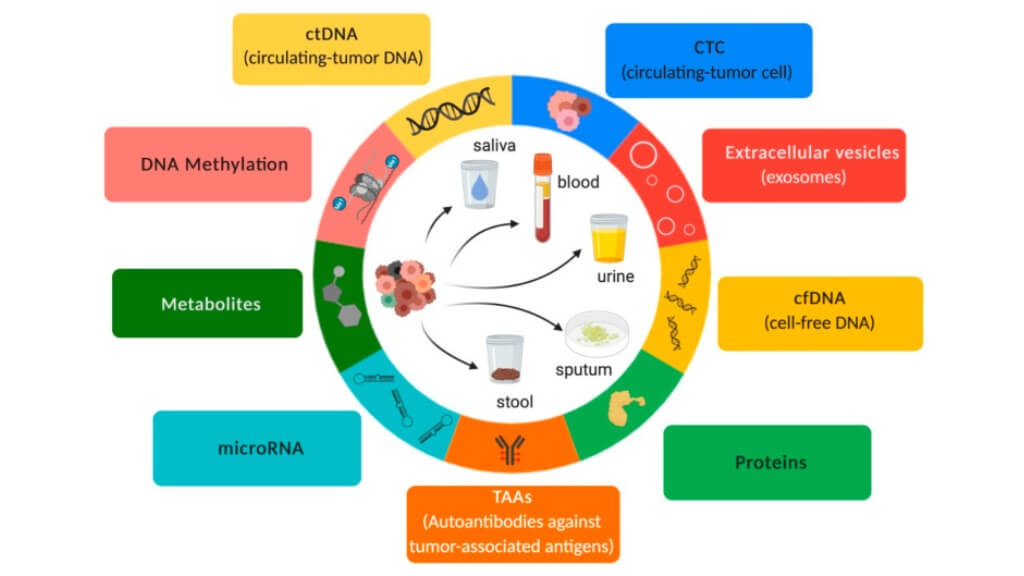
Comparative Analysis: German vs. Global Standards in Lung Cancer Detection
Several factors explain why Germany has higher detection and survival rates:
- Equipment and Technology. German hospitals continually purchase newer generations of diagnostic equipment. This is more than advanced machines – it's about having enough of them so lung cancer patients don't have to wait in long lines for necessary diagnostic procedures.
- Specialist Training & Expertise. German radiologists & pulmonologists are constantly trained. Regular certification updates are required in the medical education system so that doctors are informed of newer diagnostic and interpretation techniques.
- Systematic Screening for Lung Cancer. Germany implemented lung cancer screening programs for high-risk individuals – long-term smokers and occupationally exposed persons.
- Quality Assurance Standards. Stiff regulatory requirements ensure uniform quality of diagnostic procedures at all medical facilities.
German healthcare systems focus on rapid diagnostic workflows. The process is streamlined from initial consultation to final diagnosis to minimize delays that may allow primary tumor progression.
| Metric | Germany | EU Average | Global Average |
|---|---|---|---|
| Stage I Detection | 35-40% | 25-30% | 15-17% |
| 5-Year Survival | 85-90% | 75-80% | 60-65% |
| High-res CT Access | 95% | 80% | 60% |
| PET Scans Availability | 90% | 70% | 45% |
*Booking Health data, data from open sources
Understanding Your Lung Cancer Diagnostic Journey
In Germany, the diagnostic program for non-small cell lung cancer and small cell lung cancer is patient-centered. A possible lung cancer diagnosis is for sure an emotional stress for patients and families. As such, the whole diagnostic process is structured not only to provide correct medical information, but also emotional support and clear communication at each stage.
The First Appointment & Risk Assessment in Lung Cancer
Your path to exclude or diagnose lung cancer begins with an evaluation beyond the obvious signs and symptoms. German physicians ask about smoking history, occupational exposures, family history, and previous lung conditions. This thorough process identifies individuals whose health could benefit from early lung cancer screening without apparent symptoms.
For this first consultation, German physicians use structured questionnaires and assessment tools refined through years of clinical experience. And they know that lung cancer risk factors include asbestos, radon, diesel exhaust and other environmental carcinogens besides smoking. The assessment also considers genetics – family history of lung cancer or other cancers might influence individual risk factors.
The German physicians are trained to spot subtle patterns in symptoms that may diagnose lung cancer early. They know patients minimize or rationalize symptoms and so they ask probing questions to uncover information. This consultation might include reviewing previous chest imaging, lung function tests, or respiratory symptoms, however minor they may be to the patient.
The first consultation involves a systematic physical examination. Modern examination techniques might reveal early lung cancer or other respiratory problems. German doctors also check the health status and fitness, which is very important when choosing appropriate diagnostic approaches and possible treatment options in the case of cancer detection.
The Diagnostic Timeline in Lung Cancer
Should lung cancer be suspected, German medical centers emphasize early diagnosis. First imaging is carried out in 1-2 weeks following referral, follow-up is done in days instead of weeks and multidisciplinary consultations are performed to make treatment decisions quickly.
The German diagnostic timeline works because departments know how urgent lung cancer diagnosis is. Scheduling prioritizes suspected malignant diseases, and communication protocols assure results are reviewed and brought to work quickly.
The rapid timeline also includes patient preparation and education. German medical centers understand that patients with a suspected lung cancer diagnosis want to process information and prepare emotionally for procedures, but also have to balance this with the medical urgency of an early diagnosis.
| Process Step | Germany | Other EU Countries | Global Average |
|---|---|---|---|
| Initial CT Scan | 1-2 weeks | 3-6 weeks | 4-8 weeks |
| PET Scans (Follow-up) | 3-5 days | 2-4 weeks | 3-6 weeks |
| Tissue Biopsy Procedure | 5-7 days | 2-3 weeks | 3-5 weeks |
| Final Diagnosis | 10-14 days | 4-8 weeks | 6-12 weeks |
*Booking Health data, data from online open sources
Lung Cancer Patient Comfort and Communication
Modern procedures to diagnose lung cancer are based on patient comfort and clear communication:
- Bronchoscopy is available with conscious sedation
- Quick preliminary results where possible
- Communication throughout each step
- Scheduling to minimize multiple hospital visits
German medical centers developed protocols for physical comfort and emotional support during the diagnostic process, knowing that the experience of lung cancer diagnosis can be anxious for lung cancer patients and their families.
Conscious sedation for bronchoscopy and other invasive interventions is an important development in patient care. German anesthesiologists support diagnostic teams in keeping lung cancer patients comfortable while ensuring the safety and accuracy of diagnostics. Also, German doctors learn to explain results and next steps to diagnose lung cancer or start treatment.
Understanding Your Lung Cancer Results
German medical teams provide result discussions, including:
- Findings are explained in plain English
- Access to second opinions within the same medical system
- Connection with treatment teams as soon as cancer is confirmed
When they diagnose lung cancer, German medical centers value clear communication because patients want to make informed decisions about care. Medical teams are trained to explain medical terms in words that lung cancer patients can understand and provide complete information.
When cancer is found, German medical centers inform treatment teams and start developing treatment plans immediately. This seamless transition from lung cancer diagnosis to treatment plan development is another benefit of the integrated cancer care of the German healthcare system.
Lung Cancer Treatment Options Overview
The small cell lung cancer and non-small cell lung cancer treatment landscape has been developing rapidly, with German medical centers implementing novel therapeutic approaches. Early detection and individualizing treatment plans based on the characteristics of a patient's cancer and health status are the keys to lung cancer treatment.
Treatment Approaches at Early Stages (Stages I-II) of Lung Cancer
Early stage lung cancer treatment aims to cure by preservation of as much healthy lung tissue as possible. Depending on the patient's individual situation, German medical centers offer several advanced treatment options – either alone or in combination.
Surgery. Surgical biopsy and therapeutic surgical interventions are routinely successful when performed in specialized oncology centers for early-stage lung cancer patients:
- VATS and robotic interventions
- Preserving healthy tissue through lung-sparing procedures
For instance, VATS allows surgeons to remove tumors through small incisions using specialized instruments and high-definition cameras. It is a less painful procedure that requires less hospital time and allows faster lung function recovery than open surgery.
At German medical centers, robotic surgery systems make tumor removal precise and avoid damage to adjacent healthy tissue. These are useful in tumors in difficult anatomical regions.
Dendritic Cell Vaccination. This novel immunotherapy technique trains the patient immune system to recognize lung cancer cells. German medical centers create tailored vaccines for targeted therapy based on the patient's own immune cells.
Dendritic cell therapy got its scientific basis from research that won the 2011 Nobel Prize in Physiology or Medicine. It was awarded jointly to Bruce Beutler, Jules Hoffmann & Ralph Steinman for their work on dendritic cell role in pathogen recognition – innate immunity activation.
In dendritic cell vaccination, immune cells are isolated from the patient's blood, exposed to tumor-specific antigens in laboratory conditions, and the activated cells are infused again. The presence of "trained" DCs in the bloodstream helps the immune system develop a targeted response against lung cancer cells with minimal side effects for healthy lung tissue.
TACE (the full name is transarterial chemoembolization). In selected cases, this targeted therapy delivers chemotherapy directly to the tumor site to maximize drug concentration in the tumor and minimize systemic side effects. [5]
German interventional radiologists refined TACE techniques for better treatment efficacy and patient comfort. It involves threading a small catheter into the arteries to deliver concentrated chemotherapy into the blood supply of the tumor, then blocking the vessel to trap the medication in the tumor.
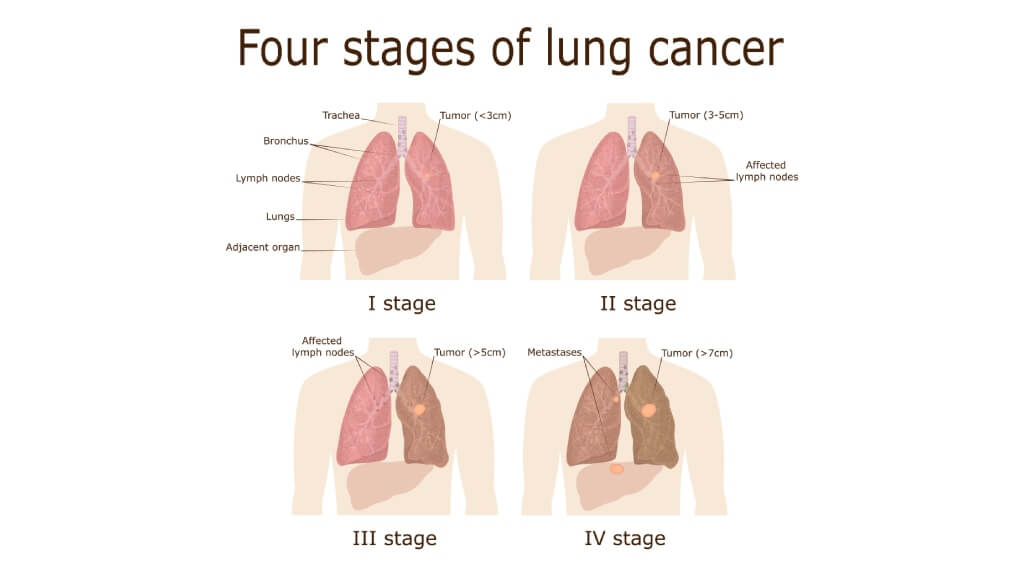
Advanced Stage Lung Cancer Treatment Options – Stages III-IV
With more advanced lung disease, German medical centers offer treatment approaches focusing on cancer control, symptom management and quality of life. Advanced stage treatment involves combination therapies tailored to the patient.
Dendritic Cell Vaccination is particularly valuable in advanced cases where immune system activation can complement other treatments. As a very targeted therapy, the vaccination approach may be combined with other therapies to increase treatment efficacy and patient quality of life during treatment.
TACE. Localized chemotherapy delivery in advanced staging may reduce tumor burden and improve quality of life. Deutsche medical teams examine each case to determine whether TACE can offer symptomatic relief and/or slow disease progression.
Hyperthermia. This therapy employs controlled heat to enhance other therapies, raising the temperature in tumor areas to make cancer cells more susceptible to chemotherapy and radiation therapy. German medical teams use protocols optimizing synergies of hyperthermia with other treatment options for effective cancer cells suppression.
Immunotherapy. Modern checkpoint inhibitors and other immune-based treatments are used in advanced lung cancer care. German oncology knows all the new immunotherapy agents and how to dose them optimally in individual patient populations.
A Medical Journey: Every Step of the Way With Booking Health
Being already exhausted from multiple treatment sessions, having consulted numerous specialists, and having tried various therapeutic interventions, finding the best treatment strategy for your clinical situation can become a challenging task. In such a situation, it is easy to choose a first-hand option or to follow standardized therapeutic protocols with a long list of adverse effects instead of selecting highly specialized innovative treatment options.
To make an informed choice and get a personalized cancer management plan, which will be tailored to your specific clinical situation, consult medical experts at Booking Health. Being at the forefront of offering the latest medical innovations for already 12 years, Booking Health possesses solid expertise in creating complex cancer management programs in each case. As a reputable company, Booking Health offers personalized stage 4 lung cancer treatment plans with direct clinic booking and full support at every stage, from organizational processes to assistance during treatment. We provide:
- Assessment and analysis of medical reports
- Development of the medical care program
- Selection of a suitable treatment location
- Preparation of medical documents and forwarding to a suitable clinic
- Preparatory consultations with clinicians for the development of medical care programs
- Expert advice during the hospital stay
- Follow-up care after the patient returns to their native country after completing the medical care program
- Taking care of formalities as part of the preparation for the medical care program
- Coordination and organization of the patient's stay in a foreign country
- Assistance with visas and tickets
- A personal coordinator and interpreter with 24/7 support
- No hidden costs
Health is an invaluable aspect of our lives. Delegating management of something so fragile yet precious should be done only to experts with proven experience and a reputation. Booking Health is a trustworthy partner who assists you in pursuing stronger health and a better quality of life. Contact our medical consultant to learn more about the possibilities of personalized treatment with innovative methods for metastatic lung cancer with leading specialists in this field.
Taking the Next Step in Lung Cancer
Regular check-ups can protect you against late lung cancer detection. So if you have risk factors or concerning symptoms – don't wait – German medical centers combine world's most advanced diagnostic capabilities with outstanding patient care.
High technology, experienced specialists and patient support systems make the diagnostic process comfortable and the early detection possible. With Booking Health, you can benefit from this excellence quickly and easily throughout your medical journey.
Contact Booking Health today to learn how German medical expertise can provide you with the thorough evaluation and peace of mind you deserve.
Modern Cancer Treatment: Patient Journeys with Booking Health
Frequently Asked Questions About Lung Cancer
Send request for treatmentFor lung cancer diagnostics in Germany high resolution CT scans/PET-CT fusion images and advanced bronchioscopy are used. German medical centers combine these technologies with AI-assisted software and specialized laboratory analysis such as tumor markers NSE, CEA and CYFRA 21-1.
High accuracy liquid biopsy for lung cancer detection is used in German medical centers. This new method analyzes circulating tumor DNA in blood and may detect cancer before it appears on imaging studies. German laboratories refined these techniques with advanced sequencing technology.
CT versus X‑ray for lung cancer diagnosis shows significant advantages of CT scans. While X-rays can only detect tumors over one centimeter and miss those hidden behind organs, CT scans detect nodules as small as 2-3 millimeters using low-dose protocols with AI assistance for enhanced CT scan accuracy.
Booking Health's diagnostics support helps you with accessing German medical centers. The BH team evaluates medical reports, selects suitable treatment locations, prepares medical documents, coordinates with clinicians and provides personal coordinators 24/7 during the diagnostic process.
Germany's lung cancer diagnostics infrastructure has the latest generation equipment with 95% high-resolution CT access and 90% PET-CT availability. The German hospitals always use the latest technology, strictly implement quality assurance standards and recruit specialists who have been continuously trained in the most advanced diagnostic techniques.
PET-CT diagnosis in Germany combines metabolic and anatomical information in one examination. It identifies cancer cell activity before structural changes appear. Germany has specialized preparation protocols for further improvement of diagnostic accuracy.
Bronchoscopy and EBUS for lung cancer diagnosis allow tissue and peripheral nodule sampling and assessment. German pulmonologists apply electromagnetic navigation bronchoscopy/endobronchial US for the evaluation of structures adjacent to airways.
Choose treatment abroad and you will be sure to get the best results!
Authors:
This article was edited by medical experts, board-certified doctors Dr. Nadezhda Ivanisova, and Dr. Bohdan Mykhalniuk. For the treatment of the conditions referred to in the article, you must consult a doctor; the information in the article is not intended for self-medication!
Our editorial policy, which details our commitment to accuracy and transparency, is available here. Click this link to review our policies.
Sources:
[1] American Cancer Society. American Cancer Society Releases Latest Global Cancer Statistics; Cancer Cases Expected to Rise to 35 Million Worldwide by 2050. https://pressroom.cancer.org/GlobalCancerStatistics2024
[2] Martin Reck, Sabine Dettmer, Hans-Ulrich Kauczor, Rudolf Kaaks et al. Lung Cancer Screening With Low-Dose Computed Tomography. Dtsch Arztebl Int. 2023 Jun 9;120(23):387–392. doi: 10.3238/arztebl.m2023.0099. [DOI] [PMC free article]
[3] Andrea Eberle, Lina Jansen, Felipe Castro, et al. Lung cancer survival in Germany: A population-based analysis of 132,612 lung cancer patients. Lung Cancer, Volume 90, Issue 3, 2015, Pages 528-533, ISSN 0169-5002. https://doi.org/10.1016/j.lungcan.2015.10.007. [DOI]
[4] Casagrande GMS, Silva MO, Reis RM, Leal LF. Liquid Biopsy for Lung Cancer: Up-to-Date and Perspectives for Screening Programs. Int J Mol Sci. 2023 Jan 28;24(3):2505. doi: 10.3390/ijms24032505. [DOI] [PMC free article]
[5] Boas FE, Kemeny NE, Sofocleous CT, et al. Bronchial or Pulmonary Artery Chemoembolization for Unresectable and Unablatable Lung Metastases: A Phase I Clinical Trial. Radiology. 2021 Nov;301(2):474-484. doi: 10.1148/radiol.2021210213. [DOI] [PMC free article]
Read:
Germany 5 Leading Hospitals for Lung Cancer Care
Article menu:
- Why Lung Cancer is Hard to Detect Early
- Advanced Lung Cancer Diagnostic Methods Available in Germany
- Comparative Analysis: German vs. Global Standards in Lung Cancer Detection
- Understanding Your Lung Cancer Diagnostic Journey
- Lung Cancer Treatment Options Overview
- A Medical Journey: Every Step of the Way With Booking Health
- Taking the Next Step in Lung Cancer
- Frequently Asked Questions About Lung Cancer
Don't know where to start?
Contact Booking Health


